18 Health Benefits of Shalabhasana & How to Do It?
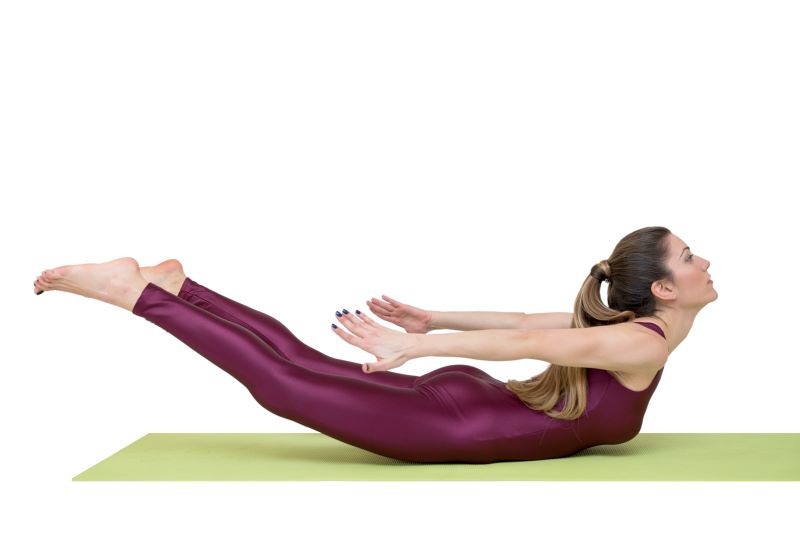
Detoxifying our body from the inside is essential for every individual. One can do this with different techniques, but boosting the body's cleaning process is natural. Yoga is an effective way to do so.
There are different yoga poses for various health issues, such as Shalabhasana, which is easy yet effective. It can strengthen your core muscles and give your body a good stretch. To learn the benefits of Shalabhasana, keep scrolling.

Table of Contents

What is Shalabhasana?
In Sanskrit, ‘Shalabha’ means locust, and asana means ‘pose’. Therefore, Shalabhasana is a yoga posture that resembles a locust. You perform this posture by lying on your belly and lifting your lower body off the ground.
Therefore, your body will rest on your belly. During the process, you need to keep your hands and legs straight. Shalabhasana is highly beneficial for core muscles, fatigue and stress. Below is a detailed list of the benefits of Shalabhasana.
How to Perform Shalabhasana?
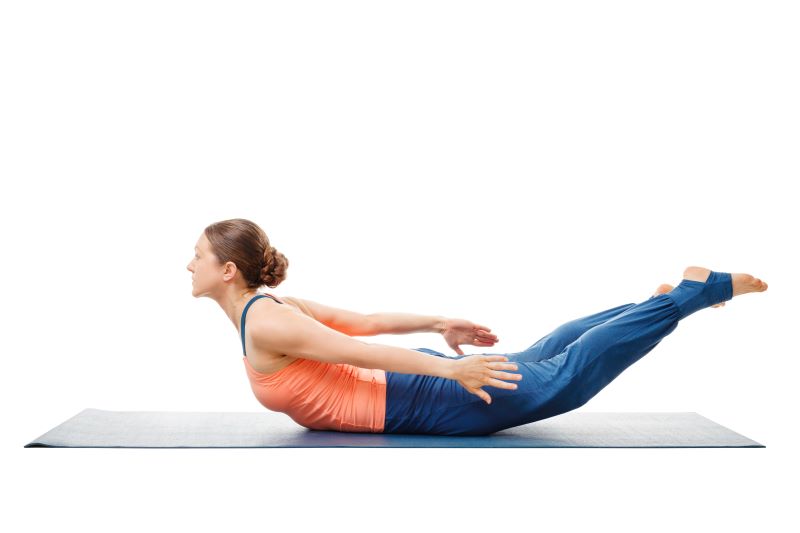
To get the maximum benefits from Shalabhasana, follow this step-by-step guide:
Step 1: Lie on your belly on a yoga mat
Step 2: Rest your hands by your side with your palms upward
Step 3: Inhale deeply and try to lift your lower portion and leg upward
Step 4: Keep your arms resting by your side while doing the pose, and keep your knees straight
Step 5: Lift the whole body weight with the support of your belly, lower ribs and pelvis
Step 6: Stay in this position for a few moments and hold your breath
Step 7: Slowly get back to the starting position
Step 8: Repeat the steps two to three times
18 Health Benefits of Shalabhasana
Shalabhasana, also known as Locust Pose, is a yoga posture that offers numerous health benefits. Here are some of the critical advantages of practising Shalabhasana:
1. Helps in Conditioning Neck and Back
Nowadays, people work for hours sitting in a single position. Therefore, the issue of a stiff neck and back is very prevalent. Shalabhasana is a perfect remedy for these issues. It helps to stretch your body and backbone, thus activating the flexibility of your body.
2. Helps in Blood Circulation
Proper blood circulation is important for healthy body functioning. Shalabhasana is highly beneficial for nurturing your heart and increasing its capability to pump blood. Further, it helps blood flow to every part of the body, ensuring the optimum functioning of body parts.
3. Aids in Weight Loss
In this posture, you must lie on your belly and stretch your whole body. Therefore, it will put a light pressure on your abdomen and waist and reduce excess fat from these areas. In modern times, lifestyle disorders and unhealthy diets cause increased weight. You can practice Shalabhasana to reduce all these issues naturally.
4. Beneficial for Shoulder and Neck
In Shalabhasana, the neck and shoulder play an important role. Therefore, these parts will undergo extreme stretching, which in turn will strengthen them. Therefore, you can tone your shoulder and neck by practicing Shalabhasana.
5. Tones Lower Back Muscles
As in this pose, you lift your lower body with belly support; therefore, the lower back muscles get tightened. So, if you want to tone your lower back muscles, Shalabhasana can be a great pose. It will help you to tone your hips and pelvis parts naturally.
6. Tones Leg and Thigh Muscles
Shalabhasana isn't just about the back and core; it also engages the muscles in your legs and thighs. As you lift your lower body off the ground, your leg muscles support the movement, resulting in toned and strengthened legs over time.
7. Beneficial Warm-Up for Sportspersons
Athletes and sportspersons must often warm their bodies effectively before engaging in rigorous physical activities. Shalabhasana is an excellent warm-up exercise, preparing the body by activating various muscle groups and enhancing flexibility. It is an ideal addition to any athlete's pre-workout routine.
8. Boosts the Body’s Metabolism
Regular practice of Shalabhasana can also improve metabolism. By stimulating the abdominal organs and promoting digestion, this pose aids in better nutrient absorption and energy production, ultimately boosting the body's metabolic rate and supporting overall health and vitality.
9. Helps to Tone the Sciatic Nerve
The sciatic nerve, which runs from the lower back down through the legs, can often become tense or compressed due to prolonged sitting or incorrect posture. Shalabhasana helps to stretch and strengthen the muscles surrounding the sciatic nerve, alleviating tension and promoting better nerve function and mobility.
10. Beneficial for Kidney and Liver
Shalabhasana's gentle compression on the abdominal area can positively affect the kidneys and liver. By improving blood flow to these organs and enhancing their efficiency in filtering toxins from the body, this yoga pose supports optimal kidney and liver function, contributing to overall detoxification and health.
11. Improves Digestive System
The gentle compression and stretching involved in Shalabhasana stimulate the abdominal organs, including the digestive organs. This can help to improve digestion, alleviate digestive discomfort, and promote regular bowel movements, leading to a healthier digestive system and enhanced overall well-being.
12. Helpful for Stimulating Appetite
If you're experiencing a lack of appetite or struggling with poor digestion, regular practice of Shalabhasana may help. By increasing blood flow to the digestive organs and promoting healthy digestion, this pose can stimulate the appetite and encourage a more balanced intake of nutrients, supporting overall nutritional health.
13. Relieves Menstrual Pain
Shalabhasana can offer relief to women experiencing menstrual discomfort. The gentle stretching and strengthening of the abdominal and pelvic muscles can help to alleviate cramps and pain associated with menstruation, providing natural relief and promoting greater comfort during this time of the month.
14. Enhances Flexibility in the Spine
Shalabhasana is a dynamic backbend that targets the entire length of the spine. By lifting the chest and arching the back, this pose helps to increase spinal flexibility and mobility, relieving stiffness and promoting a healthy range of motion in the back and vertebral column.
15. Stimulates the Nervous System
The Locust Pose activates the entire nervous system, promoting more significant nerve function and connectivity. Shalabhasana can help enhance neural communication, coordination, and overall neurological health by stimulating the spinal nerves and the brain.
16. Improves Posture
Regular practice of Shalabhasana can help correct postural imbalances and promote better spine alignment. By strengthening the muscles of the back, shoulders, and neck, this pose supports an upright posture, reducing the risk of back pain, stiffness, and related issues caused by poor posture.
17. Boosts Energy Levels
Shalabhasana is an energizing yoga pose that can help to invigorate the body and mind. By increasing circulation, oxygenation, and vitality throughout the body, this pose can help alleviate feelings of fatigue and lethargy, leaving you feeling refreshed, revitalized, and ready to tackle the day ahead.
18. Promotes Emotional Well-Being
In addition to its physical benefits, Shalabhasana can positively affect mental and emotional health. By reducing stress, anxiety, and tension in the body, this pose can promote a sense of calm, relaxation, and inner peace, helping you feel more balanced, centred, and emotionally resilient in your daily life.
The Mudras of Shalabhasana (Locust Pose)
Incorporating mudras can enhance the experience and benefits of Shalabhasana. These mudras involve specific hand gestures or locks that help channel energy and focus during the practice, amplifying its effects on the body and mind.
1. Moola Mudra
Moola Mudra, also known as the root lock, involves gently contracting the pelvic floor muscles while maintaining deep abdominal breathing. In Shalabhasana, applying this mudra helps engage the core muscles and stabilise the lower body, enhancing balance and strength.
Benefits of Moola Mudra: Moola Mudra strengthens the pelvic floor muscles, promotes stability and grounding, and stimulates energy flow throughout the body.
2. Bandha Mudra
Bandha Mudra entails the conscious contraction and control of specific muscle groups, typically the pelvic floor, lower abdomen, and throat. Integrating Bandha Mudra into Shalabhasana helps harness and direct energy upwards, facilitating a deeper connection to the core and enhancing the integrity of the pose.
Benefits of Bandha Mudra: Bandha Mudra increases internal awareness and focus, supports spinal alignment, and promotes the circulation of prana (life force energy) throughout the body.
3. Vajroli Mudra
Vajroli Mudra involves the voluntary contraction of the urethra and associated muscles. It is typically practised in conjunction with deep breathing and relaxation techniques. When applied during Shalabhasana, Vajroli Mudra can enhance pelvic stability and control, fostering a sense of inner strength and resilience.
Benefits of Vajroli Mudra: Vajroli Mudra strengthens the urinary and reproductive systems, cultivates control over sexual energy, and promotes overall vitality and well-being.
Types of Shalabhasana
Shalabhasana offers variations that cater to different levels of practice and target specific body areas. Each variation provides unique benefits and challenges, allowing practitioners to tailor their practice to individual needs and preferences
1. Superman Pose
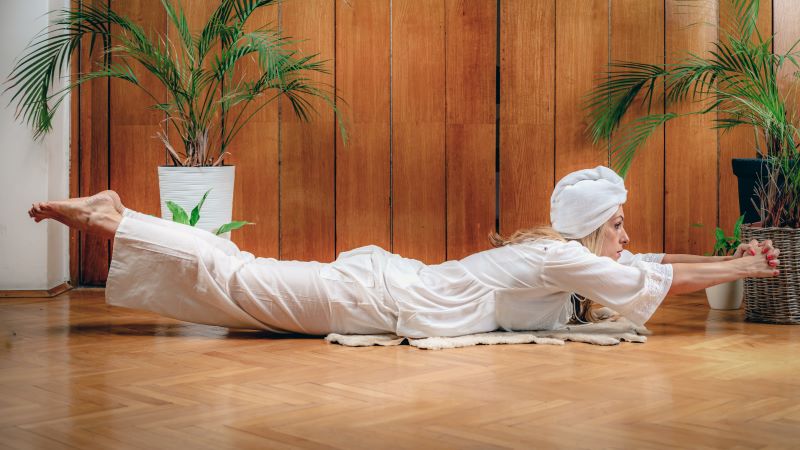
The Superman Pose, also known as "Ardha Shalabhasana," involves lifting both the upper and lower body off the ground simultaneously. With arms extended forward and legs lifted, the body resembles the flying position of the superhero Superman. This variation strengthens the back, shoulders, and glutes, improves posture, and enhances overall body awareness and control.
2. Crocodile Pose
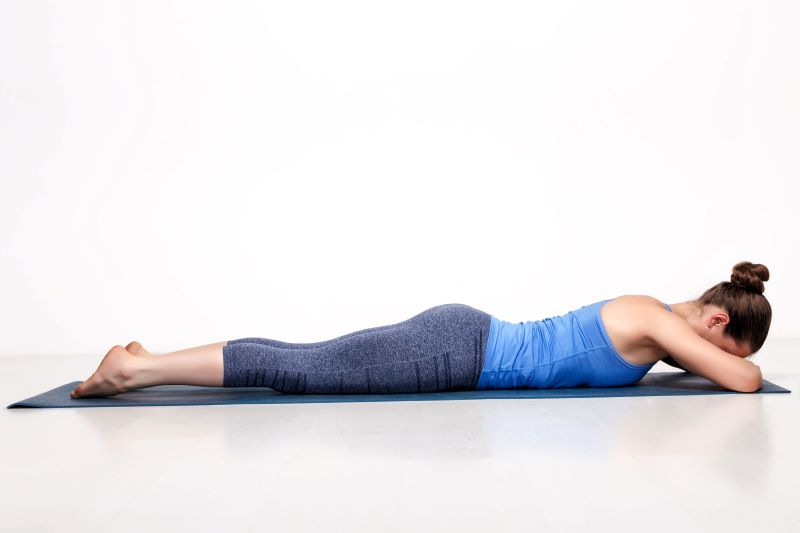
In Crocodile Pose, or "Makarasana," the practitioner lies face down with arms folded and forehead resting on the hands, resembling a crocodile floating in water. This variation provides a gentle stretch to the spine, shoulders, and neck while promoting relaxation and stress relief. This pose is ideal for beginners or those seeking a restorative posture to release tension and calm the mind.
3. Bow Pose
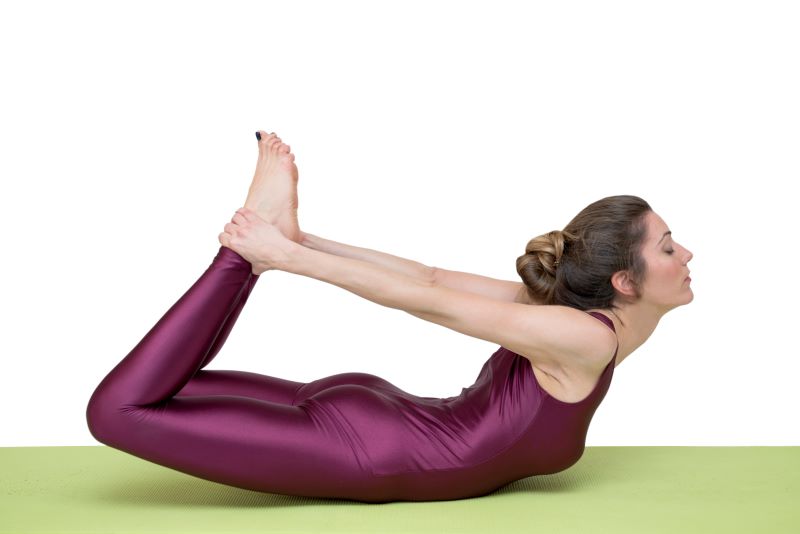
Bow Pose, or "Dhanurasana," is an intermediate to advanced variation of Shalabhasana that involves lifting the chest, arms, and legs off the ground, resembling a bow shape. This powerful backbend opens the chest, stretches the front body, strengthens the back muscles, and stimulates the digestive organs. This pose also helps to improve posture, increase spinal flexibility, and invigorate the entire body with energy and vitality.
Things to Know Before Doing Shalabhasana Yoga
Before attempting Shalabhasana, it's essential to understand the key considerations to ensure a safe and effective practice.
- Consult a Healthcare Professional: If you have any existing medical conditions or injuries, consult a healthcare professional before attempting Shalabhasana or any new exercise regimen.
- Warm-up: Always warm up your body with gentle stretches and movements before attempting Shalabhasana to prepare the muscles and joints for the pose.
- Practice on an Empty Stomach: It's recommended to practice Shalabhasana on an empty stomach or at least 4-6 hours after a meal to avoid discomfort and promote better digestion.
- Listen to your Body: Remember how your body feels during the pose, and avoid pushing yourself beyond your limits. Honour any discomfort or pain and adjust the pose as needed.
- Use Props if Necessary: If you have difficulty maintaining proper alignment or find the pose challenging, use props such as a yoga block or blanket to support your body and enhance your practice.
- Breathe Deeply: Remember to breathe deeply and steadily throughout the pose, allowing the breath to guide your movements and promote relaxation and focus.
How Long to Hold Shalabhasana Pose?

The duration of holding Shalabhasana varies depending on your level of practice and comfort level with the pose.
- For Beginners: Start by holding Shalabhasana for 10-15 seconds, gradually increasing the duration as you build strength and endurance.
- For Intermediate Practitioners: Intermediate practitioners can aim to hold Shalabhasana for 20-30 seconds, focusing on deepening the stretch and engaging the muscles more intensely.
- For Advanced Practitioners: Depending on their comfort level and capacity, advanced practitioners can hold Shalabhasana for 30 seconds to 1 minute or longer.
Risks of Overdoing Shalabhasana
While Shalabhasana offers numerous benefits, overdoing the pose can lead to potential risks and complications if not practised mindfully and with proper alignment.
- The Strain on Lower Back: Excessive lifting of the legs in Shalabhasana can strain the lower back muscles, leading to discomfort or injury.
- Neck and Shoulder Tension: Overarching the neck and shoulders during the pose can result in stress and strain in these areas.
- Compression of the Spine: Excessive pressure on the spine while holding the pose for too long can lead to compression and discomfort.
- Risk of Injury: Pushing beyond your limits or forcing the pose can increase the risk of muscle strains, sprains, or other injuries.
- Increased Stress on the Abdomen: Over-engagement of the abdominal muscles may lead to undue stress on the abdomen, potentially causing discomfort or digestive issues.
- Fatigue and Exhaustion: Overdoing Shalabhasana without adequate rest or recovery can lead to fatigue, tiredness, and decreased performance in subsequent activities.
There are various risks associated with performing Shalabhasana. Hence, it’s always a good decision to have a health insurance plan for yourself. In case any major injury happens to you, your insurance company will cover he cost of treatment if included in your policy doc.
Essential Tips for Practising Shalabhasana
As a beginner, you should perform Shalabhasana very carefully not to force your body to fit into the posture. If you follow the below-mentioned tips, you can get the maximum benefits out of it:
1. Position of Shoulders
While performing Shalabhasana, you should keep your shoulder close to the ground. This is the right way to practise this posture, which will benefit you properly. Do not lift your shoulders to your ears.
2. Leg Stretching
In this pose, you must stretch your legs by keeping them straight. Also, lift them upward enough to attain the correct posture.
3. Be Careful With Your Neck
When performing Shalabhasana, do not put excessive pressure on your neck. Keep your neck straight and your chin tucked in slightly to avoid any injury to your neck.
What are the Precautions and Contraindications of Shalabhasana?
Shalabhasana seems to be easy; however, beginners will find it challenging. In addition, neck cramps or faulty body posture can occur during this pose. Therefore, you need to maintain certain precautions to avoid any risky consequences:
- If you already have a neck injury, refrain from practising this posture
- Avoid practising if you have a hernia
- Avoid practising if you have frequent headaches
- Take advice from an expert if you are a beginner to know about the correct procedure and posture
- People with abdominal surgery should refrain from practising Shalabhasana
- Intestinal disorders and peptic ulcers should be cured fully before practising Shalabhasana
Who Should Avoid Doing Shalabhasana?
While Shalabhasana offers many benefits, specific individuals should avoid practising this pose to prevent potential discomfort or injury.
- Those with Back Injuries: Individuals with acute or chronic back injuries, such as herniated discs or spinal fractures, should avoid Shalabhasana as it may exacerbate their condition and lead to further injury.
- Pregnant Women: Pregnant women, especially those in the second and third trimesters, should avoid Shalabhasana as it involves lying on the belly and may compress the abdomen, potentially causing discomfort or compromising blood flow to the fetus.
- People with Neck Injuries: Those with neck injuries or cervical spine issues should avoid Shalabhasana, as it involves lifting the head and neck off the ground, which may exacerbate their condition and cause discomfort.
- Individuals with High Blood Pressure: People with uncontrolled high blood pressure or hypertension should avoid Shalabhasana, as it may temporarily increase blood pressure levels and pose a risk of cardiovascular complications.
- Those with Recent Abdominal Surgery: Individuals who have undergone recent abdominal surgery, such as hernia repair or appendectomy, should avoid Shalabhasana to avoid disrupting the healing process and risking complications.
- People with Severe Digestive Disorders: Those suffering from severe digestive disorders, such as inflammatory bowel disease or severe gastritis, should avoid Shalabhasana as it may exacerbate symptoms and discomfort in the abdominal region.
What are the Easy Modifications of Shalabhasana?
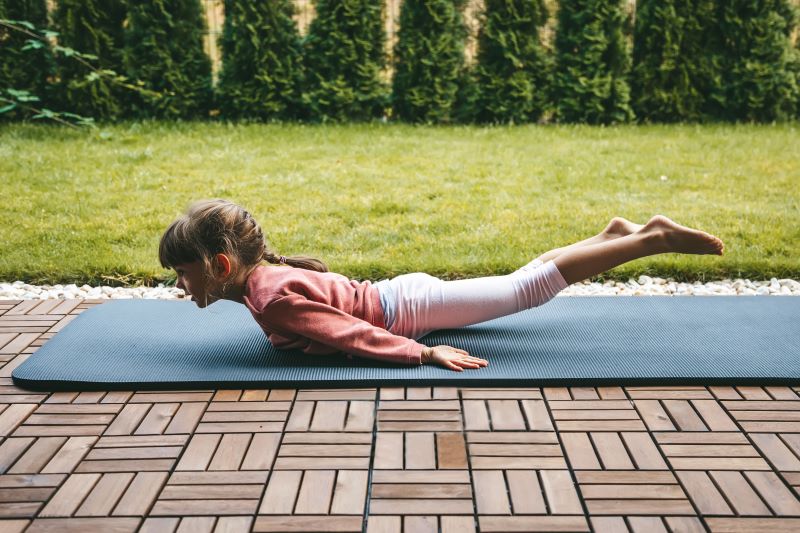
If you face issues while performing Shalabhasana, you can modify it slightly to simultaneously get the benefits and comfort. These modifications are listed below:
- Use Props: If you feel pain in your abdomen while performing the pose, try to put a soft blanket underneath. This will help you to complete the pose easily.
- Try Half Way: If you cannot raise the whole lower body in one go, you should try to raise it a bit at first. Further, you can pose by lifting one leg at a time to avoid discomfort.
- Place Your Forehead on the Floor: If you experience discomfort in your neck and chin while lifting, you can rest your forehead on the floor. You can also put a blanket under your throat and chin to avoid pain.
- Use Your Palms: In the beginning, if you can’t lift your body fully, you can use your palm for support. Hence, do not put too much force on your palm as it may harm your wrist.
Hopefully, you now have a comprehensive idea of the benefits of Shalabhasana and the necessary information related to it. Shalabhasana relaxes your body and heals it from the inside. Therefore, you need to practice your posture very carefully to get the maximum benefits without any harm. Consider this guide to learn the precautions and modifications of Shalabhasana and implement them while practising.














